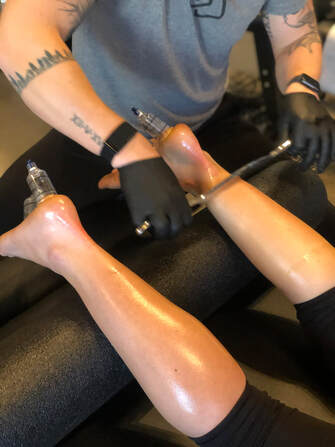Struggling with Ankle Pain?
Read On

Dealing with Achilles Tendinopathy: Causes, Home Care, and Professional Treatment
What is Achilles Tendinopathy?
[uh-KIL-eez ten-din-AH-puh-thee]
Achilles Tendinopathy, commonly referred to as Achilles Tendonitis, manifests as heel or ankle discomfort resulting from overuse. This condition occurs when the Achilles tendon, connecting the muscles of the lower leg to the heel, becomes strained. Runners and individuals aged 30-60 are particularly prone to it. While the precise cause remains uncertain, several risk factors contribute, including obesity, cold weather training, chronic diseases (such as diabetes, RA, high cholesterol), diminished muscle strength, limited ankle motion, and moderate alcohol consumption.
Recognizing Achilles Tendinopathy: Early Signs and Symptoms
Before exploring treatment options, it’s crucial to recognize Achilles Tendinopathy’s telltale signs. Look out for persistent discomfort during or after physical activity, morning stiffness, and a gradual onset of pain either at the back of the heel or just above it. Understanding these indicators can help you take timely action for relief. Additionally, consider incorporating anti-inflammatory foods into your diet, practicing mindfulness techniques, and ensuring adequate rest and hydration.
At-Home Strategies for Achilles Tendinopathy Relief
Should you suspect that Achilles Tendinopathy might be affecting you, don’t worry—there are effective home remedies readily available for your benefit. Begin your journey to recovery with tissue-loading exercises like calf raises. Initially, perform these exercises using both feet, and then shift your focus exclusively to the foot or ankle that’s causing you discomfort. It’s important to embrace the mild discomfort that may arise during these exercises, as it’s indicative of your successful tissue loading efforts. By consistently applying these methods, you’re actively working towards addressing the issue and promoting healing from within.
Professional Treatment for Achilles Tendinopathy
In the event that the discomfort you’re experiencing persists, it’s highly advisable to seek professional evaluation and treatment. Our team of experts possesses the knowledge and skills necessary to accurately diagnose Achilles tendinopathy. Once a diagnosis is confirmed, we can provide you with personalized treatment options tailored to your unique circumstances. This may encompass a range of techniques, including chiropractic adjustments, dry needling, therapeutic rehabilitation, and manual therapy methods such as Graston or Active Release. With access to specialized care, you can look forward to reclaiming optimal health for your foot and ankle. The process involves addressing not only the physical aspects of your condition but also taking into account your overall well-being to ensure a comprehensive and lasting recovery.
View this post on Instagram
View this post on Instagram
